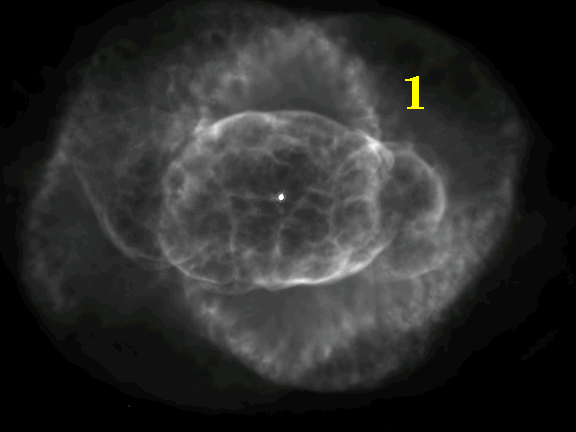Credit & Copyright: Arsen R. Hajian
(USNO),
Yervant Terzian (Cornell)
Explanation:
Watch closely.
As this animation blinks between two
Hubble Space Telescope images
of NGC 6543 - the first from 1994 and the second from 1997 -
the intricate filaments of this nebula are seen to shift.
The shift is due to the actual expansion of this gaseous shroud
shed by a dying star!
NGC 6543 is more popularly known as
the Cat's Eye Nebula.
Classified as a "planetary nebula", its complex,
interwoven shells of expanding gas have been castoff by the central star
as it evolves from a red giant to its final white dwarf phase.
The planetary nebula phase of a star's life is known to be
relatively brief, lasting 10,000 years or so.
In fact,
combined with other data,
this nebula's detectable shift over a three year period
allows the expansion age of its bright inner shells to be estimated
at only around 1,000 years while its
distance can be gauged at about 3,000 light-years.
1999 2000 2001 2002 2003 2004 2005 2006 2007 2008 2009 2010 2011 2012 2013 2014 2015 2016 2017 2018 2019 2020 2021 2022 2023 2024 2025 |
Yanvar' Fevral' Mart Aprel' Mai Iyun' Iyul' Avgust Sentyabr' Oktyabr' Noyabr' Dekabr' |
NASA Web Site Statements, Warnings, and Disclaimers
NASA Official: Jay Norris. Specific rights apply.
A service of: LHEA at NASA / GSFC
& Michigan Tech. U.
|
Publikacii s klyuchevymi slovami:
planetary nebula - NGC 6543 - Planetarnaya tumannost'
Publikacii so slovami: planetary nebula - NGC 6543 - Planetarnaya tumannost' | |
Sm. takzhe:
Vse publikacii na tu zhe temu >> | |
